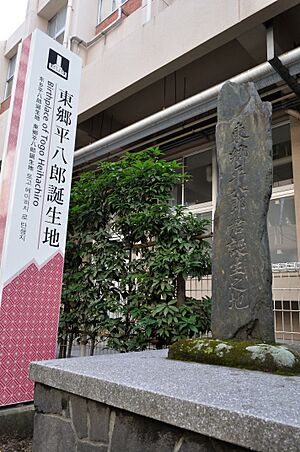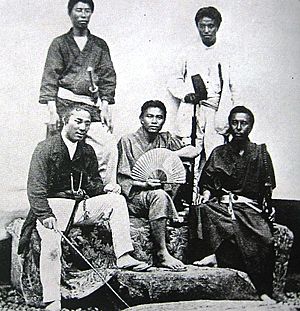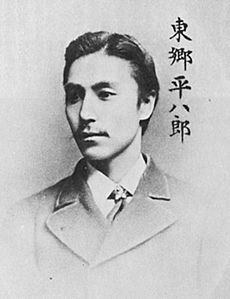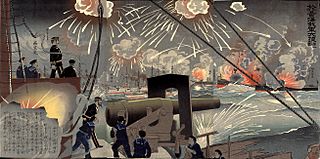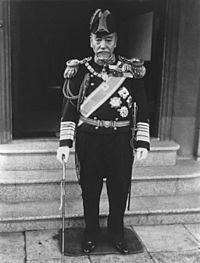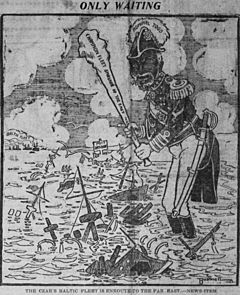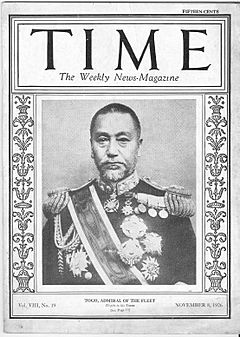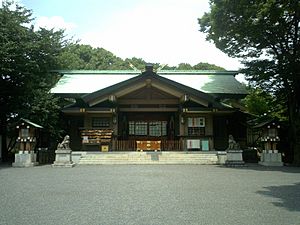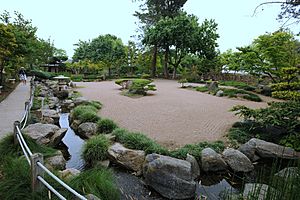Tōgō Heihachirō facts for kids
Quick facts for kids
Marquis
Tōgō Heihachirō
|
|||||
|---|---|---|---|---|---|
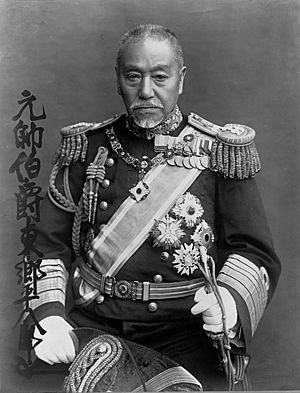
Marshal-Admiral The Marquis Tōgō Heihachirō
|
|||||
| Nickname(s) | "The Nelson of the East" | ||||
| Born | 27 January 1848 Kagoshima, Satsuma Domain |
||||
| Died | 30 May 1934 (aged 86) Tokyo, Japan |
||||
| Allegiance | |||||
| Service/ |
|||||
| Years of service | 1863–1913 | ||||
| Rank | |||||
| Commands held | Commander-in-Chief of the Combined Fleet | ||||
| Battles/wars | Anglo-Satsuma War Boshin War First Sino-Japanese War Russo-Japanese War |
||||
| Awards | Collar of the Supreme Order of the Chrysanthemum Order of the Golden Kite (First Class) Grand Cordon of the Order of the Rising Sun Grand Cordon of the Order of the Sacred Treasure Order of Merit Honorary Knight Grand Cross of the Royal Victorian Order |
||||
| Other work | Tutor to Crown Prince Hirohito | ||||
| Japanese name | |||||
| Kanji | 東郷 平八郎 | ||||
| Hiragana | とうごう へいはちろう | ||||
| Katakana | トウゴウ ヘイハチロウ | ||||
|
|||||
Tōgō Heihachirō (born January 27, 1848 – died May 30, 1934) was a famous Japanese admiral. He held the highest rank in the Imperial Japanese Navy, called gensui or Marshal-Admiral. He is known as one of Japan's greatest naval heroes.
Tōgō led the Combined Fleet during the Russo-Japanese War (1904–1905). He won a huge victory against the Russian navy at the Battle of Tsushima in May 1905. Because of his amazing skills, Western journalists called him "the Nelson of the East."
| Top - 0-9 A B C D E F G H I J K L M N O P Q R S T U V W X Y Z |
Early Life and Samurai Training
Tōgō was born as Tōgō Nakagoro on January 27, 1848. His family was noble and lived in Kagoshima, Japan. His father was a samurai who worked for the powerful Shimazu clan.
Many important people from the Meiji period were born in the same area. This was because the Shimazu clan played a big role in the Boshin War. This war led to the Meiji Restoration, a time of great change in Japan.
When Tōgō was young, he was trained to be a samurai warrior. At age 13, he changed his name to Heihachirō. This was a special ceremony for young samurai, showing they were growing up.
First Battles (1863–1869)
Tōgō's first experience in war was in August 1863. This was during the Bombardment of Kagoshima. British ships attacked Kagoshima to punish the local ruler. Tōgō, who was only 15, helped fire cannons to defend the port.
In 1866, at age 17, Tōgō joined the new Satsuma navy. In January 1868, during the Boshin War, he served on the warship Kasuga. This ship fought in the Battle of Awa, which was the first modern naval battle in Japan.
Tōgō continued to fight in battles in northern Japan. After the civil war ended in 1869, he went to Yokohama to study English. He quickly learned the language. In 1870, he joined the new Imperial Japanese Navy Training School in Tokyo.
Studying in Britain (1871–1878)
In 1871, Tōgō and eleven other Japanese cadets went to Britain to study naval skills. He spent seven years there, learning about ships and sailing. When they first arrived in London, many things seemed strange to them.
Tōgō first went to Plymouth to learn about the British Royal Navy. Then he studied history, math, and engineering in Portsmouth. He hoped to join the Royal Naval College.
When that didn't work out, Tōgō joined HMS Worcester, a training ship. He found the food small, but he worked hard. His classmates sometimes called him "Johnny Chinaman" because they didn't know much about people from Asia. Tōgō didn't like this and sometimes threatened to fight back.
In 1875, Tōgō sailed around the world on the training ship Hampshire. He saw many new places and learned a lot about sailing. He also spent time in Cambridge studying math and English.
During his time in Britain, Tōgō got very sick. His eyesight was in danger, but doctors were able to save it. After he recovered, he helped supervise the building of a new Japanese warship, Fusō.
While Tōgō was in Britain, the Satsuma Rebellion happened in Japan. Two of his brothers died fighting in this rebellion.
Return to Japan and Early Commands
Tōgō returned to Japan in May 1878 as a lieutenant. He came back on a new British-built ship, Hiei. Soon after, he was promoted and given command of his first ship in 1883. He worked with British, American, and German navies during this time.
During the Franco-Chinese War (1884–1885), Tōgō closely watched the French fleet. He also observed French soldiers fighting in Taiwan.
In 1886, Tōgō became a captain. However, he became very sick with rheumatism and had to rest for almost three years. During this time, he studied international laws about the sea.
Sino-Japanese War (1894–1895)
By 1891, Tōgō was well enough to command the cruiser Naniwa. In 1894, the First Sino-Japanese War began. Tōgō, as captain of Naniwa, sank a Chinese transport ship called Kowshing. This ship was carrying Chinese soldiers who refused to surrender.
Tōgō also fought in the Battle of the Yalu River in September 1894. His ship, Naniwa, helped sink two Chinese cruisers. After the war ended in 1895, Tōgō was promoted to rear admiral.
In 1896, Tōgō became the head of the Naval War College in Tokyo. He changed the way students were taught. He was promoted to vice admiral during this period.
When the Boxer Rebellion started in China in 1899, Tōgō was made Admiral of the Fleet. He was in charge of patrolling the Chinese coast. After the rebellion ended in 1902, he was honored for his service.
Russo-Japanese War (1904–1905)
In 1903, Tōgō was chosen to lead the Combined Fleet of the Imperial Japanese Navy. Many people were surprised, even Emperor Meiji. But the Navy Minister said Tōgō was "a man of good fortune."
During the Russo-Japanese War, Tōgō's forces fought the Russian navy at Port Arthur and the Yellow Sea in 1904. His greatest success came in May 1905 at the Battle of Tsushima.
At Tsushima, Tōgō led the Japanese navy to a huge victory. Japan was a smaller, newer naval power, while Russia had one of the world's largest navies. The Japanese fleet lost only three small torpedo boats. But out of 36 Russian warships, 22 were sunk, and six were captured. Only three Russian ships escaped.
This victory showed the world Japan's growing power. It also weakened Russia's navy and contributed to problems back home in Russia.
Life After the War
Tōgō believed he was like the famous British admiral, Horatio Nelson. In 1906, he received a special honor from the British King Edward VII. He was also given the title of hakushaku (Count) in Japan.
In 1911, Tōgō visited England again for the first time in over 30 years. He attended the coronation of King George V.
In 1913, Admiral Tōgō received the highest naval title: Marshal-Admiral. From 1914 to 1924, he was in charge of educating Crown Prince Hirohito, who would become the future emperor.
Tōgō received the highest Japanese honor, the Collar of the Supreme Order of the Chrysanthemum, in 1926. This made him the most decorated naval officer in Japan's history. His noble title was raised to koshaku (Marquis) just before he died.
Admiral Tōgō died on May 30, 1934, at the age of 86. He was given a state funeral, which is a very important ceremony. Navies from many countries, including the United States and the United Kingdom, sent ships to honor him in Tokyo Bay.
In 1940, the Togo Shrine was built in Tokyo to honor him. Tōgō himself had not wanted to be seen as a god. There are also statues of him in Japan, including one in front of the memorial battleship Mikasa in Yokosuka. The Mikasa was Tōgō's main ship during the Russo-Japanese War.
Tōgō's son and grandson also served in the Japanese Navy. His grandson died fighting in World War II.
In 1958, American Fleet Admiral Chester W. Nimitz, who admired Tōgō, helped restore the Mikasa. In return, Japanese artists built a "Garden of Peace" in Texas, which is a copy of Tōgō's own garden.
Honors and Family
Tōgō received many honors throughout his career, both from Japan and other countries. He rose through the ranks of the navy:
Tōgō's Career PromotionsRanks
Titles
|
Awards and Recognition
- Japanese Honors:
* Order of the Sacred Treasure (various classes) * Order of the Rising Sun (various classes) * Order of the Golden Kite (First Class) * Order of the Chrysanthemum (Grand Cordon and Collar)
- Foreign Honors:
* Belgium: Grand Cordon in the Order of Leopold * Korea: Grand Collar of the Order of the Golden Ruler * United Kingdom: Member of the Order of Merit (OM) * United Kingdom: Honorary Knight Grand Cross of the Royal Victorian Order (GCVO) * Italy: Knight Grand Cross of the Order of Saints Maurice and Lazarus * France: Grand Officer of the Legion of Honour * Poland: Grand Cross of the Order of Polonia Restituta * Russia: Order of St. Anna, 1st Class * Spain: Grand Cross of the Order of Naval Merit
The village of Togo, Saskatchewan, Canada, was named in his honor.
Tōgō's wife was Kaeda Tetsu. They had two sons. His elder son, Takeshi, became the second Marquis Togo after his father. His younger son, Tōgō Minoru, also became a rear-admiral in the navy.
Tōgō in Movies
Tōgō Heihachirō has been shown in films:
- In the 1969 Japanese movie The Battle of the Japan Sea, Tōgō was played by the famous actor Toshirō Mifune.
- In the TV miniseries Reilly, Ace of Spies, Tōgō was played by Robert Lee.
See also
 In Spanish: Tōgō Heihachirō para niños
In Spanish: Tōgō Heihachirō para niños


